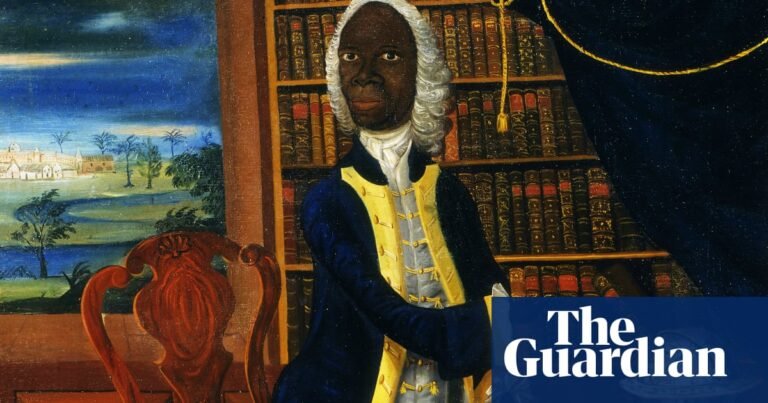It was painted to rejoice the groundbreaking achievements of a mathematical genius who was Black and had been born into slavery. However for greater than 260 years, that nice scientific mind of Francis Williams went unnoticed.
Now, clues uncovered by an X-ray and high-resolution scans of the portray have lastly revealed the extraordinary secret that 18th-century advocates of slavery sought to maintain hidden.
New proof uncovered by a Princeton historian, Prof Fara Dabhoiwala, signifies that the portray is the earliest instance in western artwork of a named Black particular person celebrating their standing as an mental.
The portrait of Williams, a rich Jamaican polymath who was free of slavery as a toddler, was purchased by the furnishings curator of the Victoria and Albert Museum in 1928, primarily as a result of it depicted tremendous mahogany furnishings.
It has lengthy been mistaken for a satirical portray that mocks its Black topic for having the temerity to fake to be a Georgian gentleman and scholar. However it’s now thought to have been commissioned in 1760 by Williams himself to immortalise his brilliance as a trailblazing astronomer who, the clues within the portray recommend, efficiently managed to compute and witness the trajectory of Halley’s comet over Jamaica in 1759.
This dazzling mathematical breakthrough, which vindicated Edmond Halley’s predictions in 1705 about when the comet would reappear and proved Isaac Newton’s common principle of movement and gravity for the primary time, was solely credited to white astronomers who observed Halley’s comet elsewhere.
It’s only due to the newly uncovered proof hidden within the portray that Williams – who was proposed as a fellow of the Royal Society at a gathering Newton and Halley attended in 1716, however was later rejected by a small committee “on account of his complexion” – can lastly assert his place as a pioneering Black mental within the historical past of science.
When Dabhoiwala realised {that a} scan of the portray revealed new titles within the bookcase, he was in a position to date the portray to across the time of the comet, many years after it was beforehand thought to have been painted.
Dabhoiwala additionally found the importance of the web page quantity rigorously inscribed on the e-book Williams is studying: it’s the web page within the third version of Newton’s Principia that discusses find out how to calculate the trajectory of a comet by reference to the constellations round it.
An X-ray of the window scene depicted within the background of the portray confirmed traces intersecting what seems to be a luminous white comet, streaking by means of the sky at nightfall, and connecting – with gorgeous accuracy – to constellations of stars. These stars would have been seen in that place within the firmament when Halley’s comet was within the sky over Jamaica in 1759, based on analysis by Dabhoiwala.
“I feel this portray is making a extremely highly effective assertion,” stated Dabhoiwala, who’s giving a public lecture at the V&A on Wednesday night about his findings, which may also be printed within the London Review of Books. “It’s saying: ‘I, Francis Williams, free Black gentleman and scholar, witnessed a very powerful occasion within the historical past of science in our lifetimes, the return of Halley’s comet. And I calculated its trajectory, based on the principles of the third version of Isaac Newton’s Principia’.”
He stated the comet’s reappearance was “immensely vital to all educated, mental individuals across the western world at the moment. Everyone seems to be ready for Halley’s comet as a result of it’s going to show that Newtonian science – fashionable science – works, that all the things is affected by gravity, that we have now found out the common precept on the coronary heart of the universe … Nevertheless it additionally has a deeply private resonance for Francis Williams, as a result of most likely nobody else outdoors Europe was nonetheless alive who had met and conversed with Halley and Newton. They’ve all died.”
Devices for drawing and making advanced mathematical calculations are depicted on the desk in entrance of Williams. “I feel that’s exhibiting that he’s been doing that,” stated Dabhoiwala.
By 1759, Williams had inherited a big property in Jamaica, together with plantations and enslaved individuals, from his previously enslaved African father. After establishing a faculty for younger, free Black individuals, he died childless in 1762. Nothing he wrote about his mental endeavours has ever been discovered. “He’s a Black man in a white supremacist society. Nobody thinks it’s value preserving something by him,” Dabhoiwala stated.
His portrait was bought to the V&A by the descendants of Edward Lengthy, a white plantation proprietor and historian who, together with the Scottish enlightenment thinker David Hume, had mocked Williams’ mind in print, lending credence to the concept the portrait will need to have been satirical.

